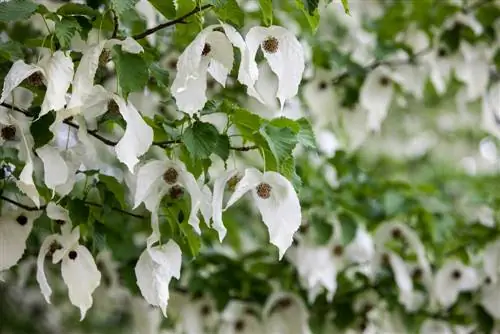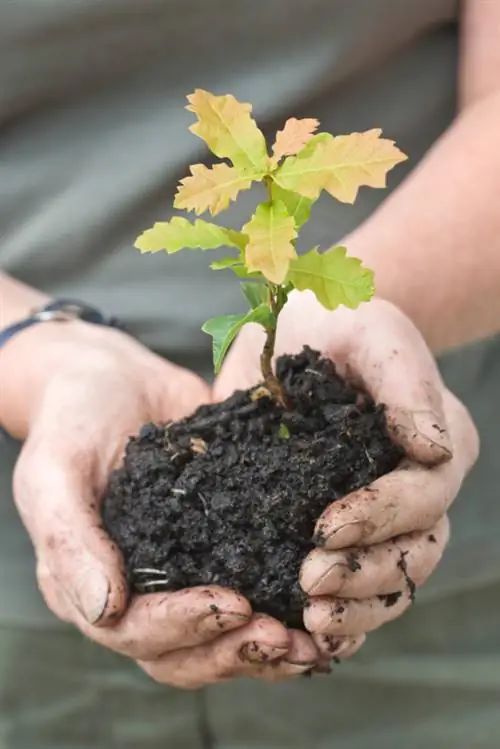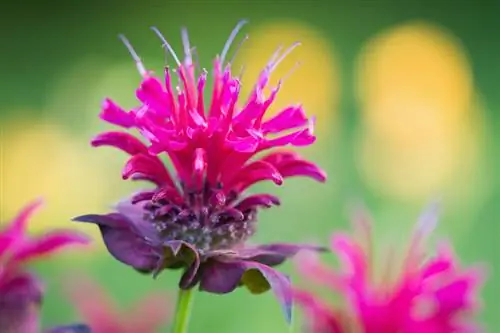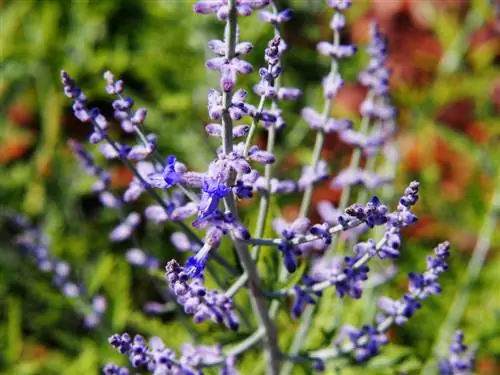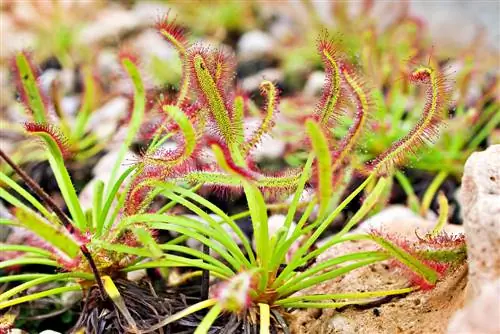- Author admin [email protected].
- Public 2023-12-16 16:46.
- Last modified 2025-01-23 11:22.
The handkerchief tree is one of the most spectacular ornamental trees from Mother Nature's hand. Where its white petals sway in the wind, they are reminiscent of handkerchiefs on a line or a flock of fluttering doves. Do you love the gardening challenge? Then clarify any open questions about cultivation here.

How to care for a handkerchief tree in the garden?
The handkerchief tree (Davidia involucrata) is an ornamental tree known for its white, dove-like flowers. To cultivate it, choose a sunny location with nutrient-rich, moist soil. Plant in autumn and pay attention to regular watering and fertilization.
Planting the handkerchief tree correctly
To ensure that the pigeon tree becomes an eye-catching highlight in the garden, you can direct its growth in the right direction with proper planting. Choose a sunny location with nutrient-rich, fresh, moist soil. The optimal planting date is a mild, dry day in autumn with overcast weather. While you prepare the bed soil, the root ball is soaked in soft water until no more air bubbles appear. This is how the planting goes according to all the rules of gardening:
- The planting pit has 1.5 times the volume of the root ball
- Shovel the excavation into a wheelbarrow and mix it with compost (€12.00 on Amazon) and horn shavings
- Drive a support post into the planting hole
- Place the young pigeon tree in the pit and plant it up to the root neck
- Prune back 20-30 percent of baled goods and bare root goods
Tread the substrate firmly and water the handkerchief tree with collected rainwater or decalcified tap water. Finally, connect the trunk to the support post and spread a layer of mulch.
Care tips
The care program for the pigeon tree begins on the day of planting, because a regular supply of water is essential for he althy growth. In a rainy autumn, however, watering must not be excessive, as waterlogging is absolutely fatal for a young handkerchief tree. Before the first frost sets in, cover the tree disc thickly with leaves and wrap the crown and trunk with garden fleece or jute ribbons. If the winter is dry and cold, water the tree on mild days. The normal care protocol begins in April with the removal of winter protection:
- Keep the tissue tree constantly slightly moist
- Provide with slow-release fertilizer in April and July
- Alternatively, fertilize organically every 3-4 weeks until August
- Prune only if necessary in February/March, taking into account the buds that have already formed
Repeat the winter protection measures for the first 10 years, as a pigeon tree first has to develop its frost hardiness. Later, the precautions are reduced to leaning wooden boards against the trunk so that the intense winter sun cannot damage the sensitive bark.
Which location is suitable?
The pigeon tree finds the ideal feel-good atmosphere in a sunny to semi-shady location, protected from the wind and surrounded by other trees. Since the roots react sensitively to disturbances, we recommend a location within lawns and not necessarily in the more turbulent environment of a bed. In addition, proximity to garden paths should be avoided due to the soil compaction that occurs there.
The correct planting distance
Since a pigeon tree in the Central European climate reaches a height of 2 to 5 meters and its maximum height of 10 meters after 50 years at the earliest, it is considered a small tree. If you measure the expected tree height as the minimum distance from the house, you are exactly right. In neighborhood law, the planting distance from neighboring properties is precisely defined, but varies in the federal states. As a rule of thumb, a tree with a height of more than 2 meters should be planted at a distance of at least 2 meters from the neighbor. The responsible public order office will provide the exact value for your region.
What soil does the plant need?
So that you can enjoy the sensational flowers as quickly as possible, the soil quality should be chosen as follows:
- Nutritious, humic and, above all, constantly slightly moist
- Well drained, without risk of waterlogging
Check the soil reaction in advance, because a slightly acidic to minimally alkaline pH value is very beneficial for the pigeon tree.
What is the best time to plant?
By planting in autumn, you provide the pigeon tree with perfect starting conditions in the bed. Since the soil is deeply warmed by the sun at this time of year, the sensitive roots can establish themselves excellently until winter knocks on the garden gate. Alternatively, early spring is a good time to plant so that the handkerchief tree has enough time to root before winter.
When is flowering time?
The pigeon tree presents its first handkerchief blossom after an average of 8 years. From April to June/July the white petals that give the tree its name unfold. With a targeted supply of nutrients you can influence the flowering time. If you fertilize predominantly with nitrogen, the ornamental tree will concentrate on height and foliage growth. If you focus on a phosphorus-rich fertilizer from July onwards, the focus will be on bud formation.
Cut the tissue tree correctly
The pigeon tree does not require annual pruning as it naturally develops a beautiful habit and grows in size very slowly. If you still want a shape and maintenance cut, proceed as follows:
- Cut off shoots that are too long on a frost-free day in February
- Place the scissors at a slight angle 2-3 mm above an outward-facing eye
- Cut dead wood and stunted branches at the base
When making every cut, please note that a pigeon tree sets its buds the previous year. If you cut too deeply into the branches, in the worst case scenario you will deprive yourself of the flower spectacle you were hoping for in spring.
Watering the tissue tree
Water a pigeon tree regularly if the natural rainfall is insufficient. The tree, which is quite sensitive, cannot cope with drought stress any more than it can withstand waterlogging. Check the soil in the container every few days to water as soon as the top 3-4 cm has dried out. Use soft rainwater and normal tap water alternately to effectively prevent excess lime in the soil.
Fertilize the handkerchief tree properly
In terms of nutrient supply, a pigeon tree is frugal and undemanding. How to handle this care topic correctly:
- Administer a complete fertilizer in April and July
- Alternatively, from April onwards, add compost with horn shavings superficially every 3-4 weeks
- Apply a liquid fertilizer in the bucket or fertilize with sticks or cones
From August onwards, a handkerchief tree should no longer be fertilized so that its shoots can mature well until the first frost.
Wintering
A pigeon tree has to develop its winter hardiness over the years. Only at an advanced age can it tolerate frost down to -15 degrees Celsius. As a result, the tree depends on your support to get through the cold season he althy. This is how you protect the gem in the bed from damage:
- Heap the tree slice thickly with autumn leaves and needles
- Cover the crown with fleece or a shading net
- Protect the trunk from the winter sun with jute ribbons, in later years with wooden boards
- Remove the winter protection again by mid-April at the latest
Continue to water the dove tree in winter if there is no rain or snow. If damage occurs, it results much more often from drought stress than from frost.
How do I transplant correctly?
A pigeon tree is loyal to its location and has difficulty coming to terms with disturbances. Transplanting is therefore rarely successful. If a change of location is unavoidable, it should be carried out within the first five years of operation, with a preparation period of 1 year. Here's how to do it:
- In autumn, cut off the roots in as large a radius as possible with a spade
- Dig a small trench 10-15 cm wide around the root ball
- Fill this trench with a mix of garden soil, compost and leaf mold
- Water regularly until next autumn so that numerous fine roots develop
The following autumn, lift the pigeon tree out of the ground to plant it in the new location.
Handkerchief tree in pot
In a large pot, a pigeon tree requires much more attention than in a bed. Only choose this form of cultivation if you already have many years of experience as a hobby gardener. Use high-quality compost-based potting soil as a substrate, optimized with lava granules or expanded clay. Insert a drainage made of pottery shards above the water drain to protect against waterlogging. This is how care is carried out professionally:
- Keep the pigeon tree evenly moist without causing waterlogging
- Watering alternately with soft rainwater and tap water
- Fertilize with nitrogen in April and phosphorus in July
- Repot every 2-3 years into a larger pot and fresh substrate
Since the root ball in the pot is always at risk of freezing in the winter, you cannot avoid taking adequate precautions. Before the first frost, cover the pot with bubble wrap and cover the substrate with leaves, wood wool or straw. Place a block of wood under the pot so that the cold does not attack from below. The crown is given a hood made of breathable fleece or jute ribbons. Protect the trunk from the intense winter sun with raffia or reed mats.
Is handkerchief tree poisonous?
The pigeon tree is perfect as a house tree for a family with children and pets. There are no toxic components in its leaves, flowers or fruits.
How is it possible to grow from seeds?
Sowing seeds of a handkerchief tree requires a fair amount of patience and expertise. In the wild, the hard-shelled seeds take up to 18 months before they decide to germinate. If you don't want to wait that long, use the gardening trick of stratification. This is how it works:
- Fill a small plastic box with slightly damp sand and place the seeds there
- Store in the vegetable compartment of the refrigerator for 4-8 weeks
- Then fill small pots with potting soil and insert one seed into each 1 cm deep
Keep constantly moist in a partially shaded window seat at 18-20 degrees Celsius until the cotyledons appear. Then place it a little cooler, continue to water regularly and fertilize every 4 weeks with highly diluted liquid fertilizer.
Trivia
The elaborate search for the handkerchief tree resulted in the first step in the discovery of the kiwi. After the English plant hunter Ernest Henry Wilson arrived in China in 1899 and was disappointed to find that the first pigeon tree discovered 35 years earlier had been felled, he set out to search for more specimens. Before he found what he was looking for in Hubei Province in May 1900, he discovered an unusual climbing plant with delicious fruits, now known as kiwi.

